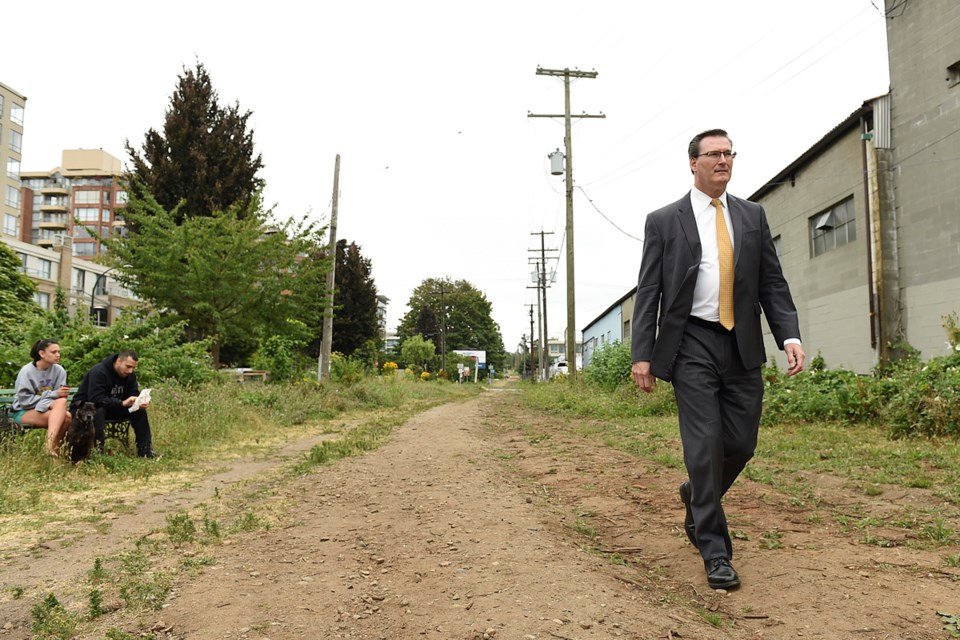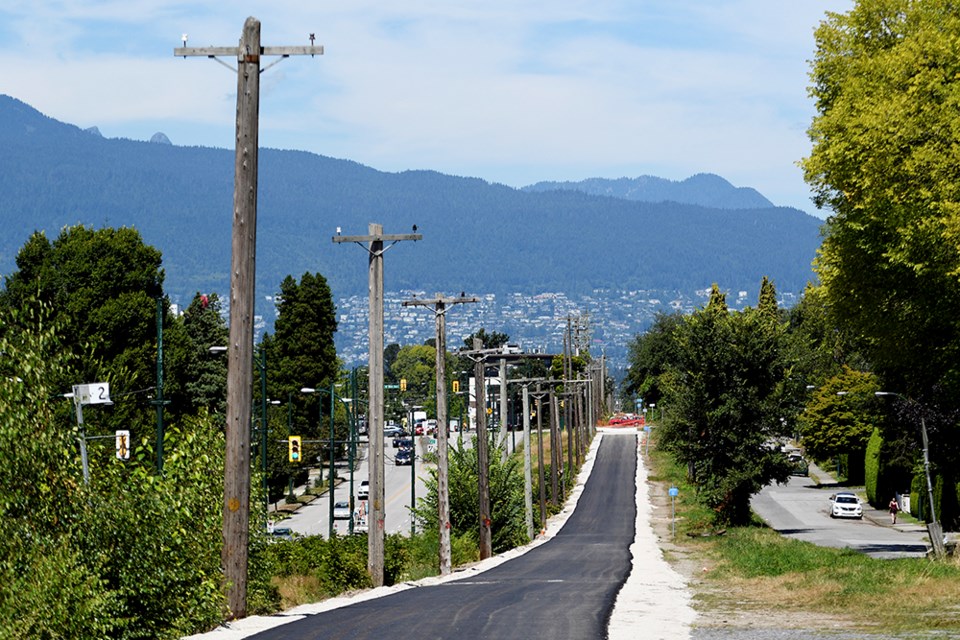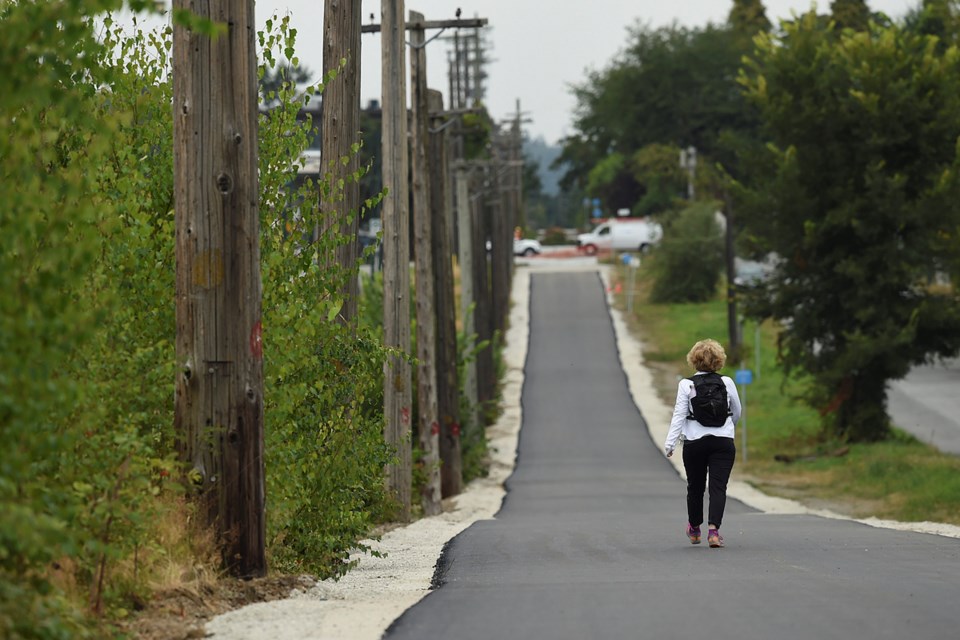City crews have already laid asphalt down on a chunk of the Arbutus Greenway — from 16th to about 25th. The next goal is to pave the segment up to 41st over the next few weeks, and ultimately the whole nine-kilometre route from False Creek to the Fraser River.
Jerry Dobrovolny, the city’s general manager of engineering, said the temporary path is meant to encourage the public to travel along the route in preparation for the launch of the visioning process this fall, which will examine what the corridor can become.
“The goal is to get people using more of the corridor. We’ve heard from people who’ve lived next to the corridor for decades, but still may have walked only one or two blocks,” said Dobrovolny during a Tuesday press conference at the portion by Fir and West Fifth. He noted Canadian Pacific contractors finished removing the track ahead of schedule and the asphalt is being put down where the rail used to be. It will be open for public use as each section is completed.
“Our goal is to get people walking much more of it. If you’ve walked two blocks, walk two kilometres. If you’ve walked two kilometres, walk eight kilometres. Experience it, see it and use it. And use that experience when you come to our open houses and involve yourself in our consultation process to design what will be a spectacular facility for the City of Vancouver.”

Dobrovolny maintains the more people have experienced the corridor, and its “amazing vistas”, the better equipped they will be to offer input. At this point, he said the discussion about possibilities is wide open.
“The sky’s the limit,” he said.
But discussions will likely include how to incorporate subjects such as First Nations history, active transportation, art, culture, the bird migratory path and innovative lighting.
Staff are still being hired for the Arbutus Greenway team. When consultation starts in September, it will begin with a “listening and learning” portion, according to Dobrovolny.
When that’s over, staff will create draft proposals that will also be subject to public feedback. Staff will make adjustments based on that input and come back with a recommended option.
The process will take at least a year and possibly up to two years. Dobrovolny said he doesn’t want to put constraints on the schedule.
“Right now we’ve had all kind of ideas — somebody did their thesis at UBC looking at uses for old rail cars, to keep the rail theme along the corridor. As I mentioned, it’s a migratory pathway for birds. There’s all kinds of opportunities… around cultural significance, around public art,” he said. “So at this point, I’m hesitant to say, ‘In this amount of time we’ll have started and be finished.’ We’re going to open the door up and have a good, fulsome dialogue and see where it takes us.”
When asked about some residents’ concerns that increased use of the corridor will disrupt the quiet, Dobrovolny said it’s meant to be an active transportation corridor for uses such as walking, jogging, biking and rollerblading, while offering a chance for people to explore and experience nature.

Community gardens, which are registered with the city, already exist along the route, but the city anticipates there will be opportunities for more such gardens, as well as opportunities to increase the tree canopy and meet other city goals.
But Dobrovolny cautioned that it’s not a free for all for community gardening.
“Our goal is to have more gardens along the corridor, but it would be done in a managed way. First, we’ve got to figure out how to design the corridor and what needs would be accommodated,” he said.
Dobrovolny told the Courier last week some existing gardens have crept into the right of way. City workers are putting string out to clearly show them where the line is — where they should and shouldn’t be. Once the growing season is over, staff will look at having them pull back to where they’re allowed to be.
“The whole thing is we don’t want people creeping into the right of way at the same time as we’re working with partners to decide what to do in the right of way,” he told the Courier.
“It’s not fair that someone just jumps the gun and lays claim to a piece of land while others engaged in the process are respectfully talking about what to do with this land.”
Meanwhile, not everyone is happy about the asphalt path, including some members of Cypress Community Garden, as well as members of an organization called Concerned Residents and Corridor User Group.
They maintain the city didn’t consult corridor users and residents before putting down the asphalt, which they consider “ugly, hot and will cause serious runoff problems.”
They insist a simple pathway could easily have been created by tamping the route down to form a firm surface to allow wheeled vehicles to travel along it, and that crushed gravel, or an alternative that’s water permeable, is far preferable to asphalt.
Safety is also a concern: they worry bikes, skateboarders and rollerbladers travelling down the incline near the Cypress Community Garden — if it’s paved — will create the potential for accidents with seniors, people with strollers, those in wheelchairs or those using walkers.
Adrian Levy, chair of Cypress Community Garden, said members have an appointment to meet with city staff Aug. 8. He’s hopeful they can convince the city to finish the path using a different material.
“It will be less expensive, it will be safer, it will be cleaner and it will be green — not black,” he said.
@naoibh
Note: This story has been updated since first posted.



